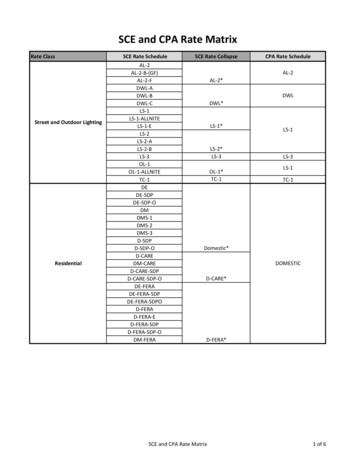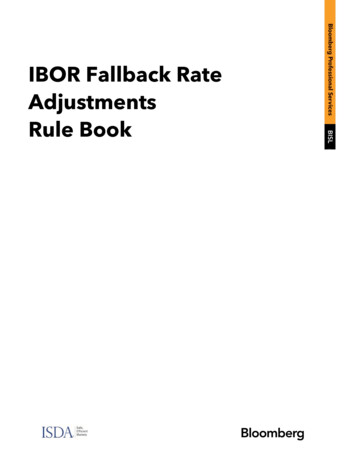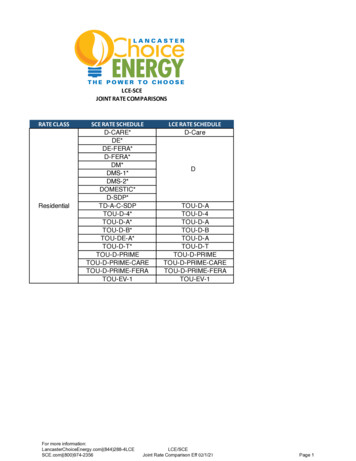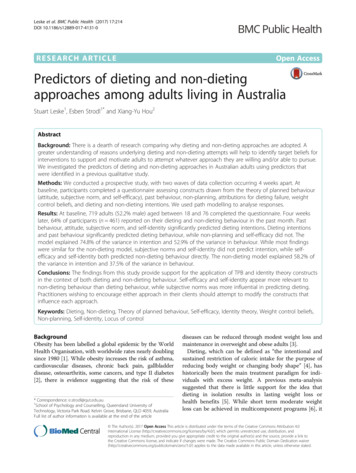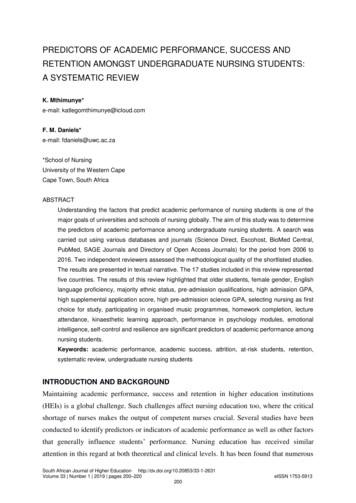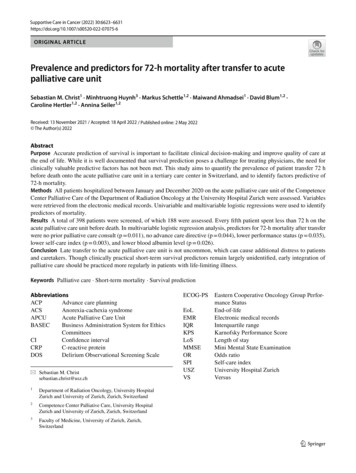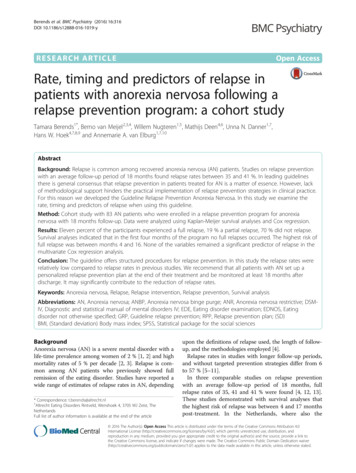
Transcription
Berends et al. BMC Psychiatry (2016) 16:316DOI 10.1186/s12888-016-1019-yRESEARCH ARTICLEOpen AccessRate, timing and predictors of relapse inpatients with anorexia nervosa following arelapse prevention program: a cohort studyTamara Berends1*, Berno van Meijel2,3,4, Willem Nugteren1,5, Mathijs Deen4,6, Unna N. Danner1,7,Hans W. Hoek4,7,8,9 and Annemarie A. van Elburg1,7,10AbstractBackground: Relapse is common among recovered anorexia nervosa (AN) patients. Studies on relapse preventionwith an average follow-up period of 18 months found relapse rates between 35 and 41 %. In leading guidelinesthere is general consensus that relapse prevention in patients treated for AN is a matter of essence. However, lackof methodological support hinders the practical implementation of relapse prevention strategies in clinical practice.For this reason we developed the Guideline Relapse Prevention Anorexia Nervosa. In this study we examine therate, timing and predictors of relapse when using this guideline.Method: Cohort study with 83 AN patients who were enrolled in a relapse prevention program for anorexianervosa with 18 months follow-up. Data were analyzed using Kaplan-Meijer survival analyses and Cox regression.Results: Eleven percent of the participants experienced a full relapse, 19 % a partial relapse, 70 % did not relapse.Survival analyses indicated that in the first four months of the program no full relapses occurred. The highest risk offull relapse was between months 4 and 16. None of the variables remained a significant predictor of relapse in themultivariate Cox regression analysis.Conclusion: The guideline offers structured procedures for relapse prevention. In this study the relapse rates wererelatively low compared to relapse rates in previous studies. We recommend that all patients with AN set up apersonalized relapse prevention plan at the end of their treatment and be monitored at least 18 months afterdischarge. It may significantly contribute to the reduction of relapse rates.Keywords: Anorexia nervosa, Relapse, Relapse intervention, Relapse prevention, Survival analysisAbbreviations: AN, Anorexia nervosa; ANBP, Anorexia nervosa binge purge; ANR, Anorexia nervosa restrictive; DSMIV, Diagnostic and statistical manual of mental disorders IV; EDE, Eating disorder examination; EDNOS, Eatingdisorder not otherwise specified; GRP, Guideline relapse prevention; RPP, Relapse prevention plan; (SD)BMI, (Standard deviation) Body mass index; SPSS, Statistical package for the social sciencesBackgroundAnorexia nervosa (AN) is a severe mental disorder with alife-time prevalence among women of 2 % [1, 2] and highmortality rates of 5 % per decade [2, 3]. Relapse is common among AN patients who previously showed fullremission of the eating disorder. Studies have reported awide range of estimates of relapse rates in AN, depending* Correspondence: t.berends@altrecht.nl1Altrecht Eating Disorders Rintveld, Wenshoek 4, 3705 WJ Zeist, TheNetherlandsFull list of author information is available at the end of the articleupon the definitions of relapse used, the length of followup, and the methodologies employed [4].Relapse rates in studies with longer follow-up periods,and without targeted prevention strategies differ from 6to 57 % [5–11].In three comparable studies on relapse preventionwith an average follow-up period of 18 months, fullrelapse rates of 35, 41 and 41 % were found [4, 12, 13].These studies demonstrated with survival analyses thatthe highest risk of relapse was between 4 and 17 monthspost-treatment. In the Netherlands, where also the 2016 The Author(s). Open Access This article is distributed under the terms of the Creative Commons Attribution 4.0International License (http://creativecommons.org/licenses/by/4.0/), which permits unrestricted use, distribution, andreproduction in any medium, provided you give appropriate credit to the original author(s) and the source, provide a link tothe Creative Commons license, and indicate if changes were made. The Creative Commons Public Domain Dedication o/1.0/) applies to the data made available in this article, unless otherwise stated.
Berends et al. BMC Psychiatry (2016) 16:316present study has been conducted, research by VanElburg [14] showed a relapse rate of more than 50 %over a period of five years. In none of these studies astructured relapse prevention program was applied.In leading guidelines in the field of eating disorders[15–17], general consensus exists that relapse preventionin patients with AN is essential. However, a major problem is the lack of structured methods for relapse prevention to support professionals in clinical practice. Thereforthe Guideline Relapse Prevention Anorexia Nervosa(GRP) was developed, intended for use by both professionals and patients to apply relapse prevention strategiesin a structured manner [18]. This Guideline was implemented in specialized treatment setting for eating disorders in The Netherlands.The aim of the present study is to examine the rate,timing and predictors of relapse of patients who weretreated with the GRP.MethodDesignCohort study of patients successfully treated for ANincluded in a relapse prevention program for AN, with afollow-up of 18 months.Page 2 of 7depression with a risk of suicide). The remaining 83participants were included in the analyses.The study was carried out in a specialized treatmentcenter for eating disorders in the Netherlands, AltrechtEating Disorders Rintveld. The treatment provided inthis specialized setting is based on the state-of-the-artevidence- and practice-based knowledge as described inthree guidelines: The Dutch Multidisciplinary GuidelineEating Disorders [15], the NICE guidelines Eating Disorders [16] and the American Psychiatric AssociationPractice Guideline: Treatment of Patients with EatingDisorders [17]. Treatment focuses on three areas: (1)eating habits, body weight, and body image; (2) psychological aspects of functioning, such as self-esteem, perfectionism, and traumas; and (3) social functioningwithin the family system and in society. In our center,patients are basically treated on an outpatient basis, andonly admitted for short periods at a time, followed byoutpatient treatment. All patients who started therelapse prevention program received prior outpatienttreatment. Only when remission was reached duringoutpatient treatment were patients eligible for participation in the aftercare program. Comorbidity is managedeither in the center itself or by co-treatment in a different specialized center.Participants and settingThe following inclusion criteria were applied: in- andoutpatients, age 12 years and older, meeting the diagnostic criteria of the DSM-IV [19] for AN or EDNOS clinically referred to as AN (for example women meeting allcriteria for AN, except that the individual has menses. In33 cases the diagnosis was determined according to theDSM-IV criteria and ascertained by eating disorder experts (all psychiatrists), supported by questions from theEDE (Eating Disorder Examination) [20, 21]. In 50 casesthe actual EDE interview was administered to confirmthe eating disorder diagnosis that was determined by thepsychiatrist in accordance with the DSM-IV criteria.Participants had successfully completed their treatment, were weight restored with a normal (SD) BMIbased on their age and height. For inclusion it was further required that they had drawn up a relapse prevention plan (RPP) at the end of their treatment.Ninety-six patients were eligible to participate in theafter-care program between 2009 and 2012, where theGuideline Relapse Prevention Anorexia Nervosa (GRP)was implemented. Thirteen participants did not meetthe inclusion criteria: seven participants did not have acomplete RPP, two patients were re-admitted for treatment during the drafting of the RPP, two participants refused to participate in the after-care program after makinga RPP, one patient moved abroad before starting the aftercare program, and one patient was admitted to a closedward during this study due to severe comorbidity (severeDefinition of relapseIn the present study the primary outcome was the occurrence of relapse. The distinction was made betweenfull and partial relapse. A full relapse was defined as:BMI 18.5 for adults and SD BMI -1 for adolescents,together with full recurrence of the core diagnosticsymptoms of AN according to DSM-IV criteria, in thefirst instance assessed by the professional, and next confirmed in a multidisciplinary consensus meeting. In case ofconfirmation, this formed an indication for renewed treatment. Partial relapse was defined as the re-occurrence ofone or more core diagnostic symptoms of AN, after a previous positive response to treatment. As a response to there-occurrence of symptoms, a temporary intensification ofthe after-care program for a period up to three monthswas needed to achieve full recovery again. If a longer intensification of the program was needed the relapse wasclassified as a full relapse.The guideline relapse prevention anorexia nervosa (GRP)The primary aim of the guideline is that the professional,patient and her relatives work closely together to gain abetter understanding of the patient’s individual processof relapse. Triggers and early warning signs that preceded previous relapses are identified and elaborated forthe individual patient, and actions are formulated thatcan be performed in the event of a new impending relapse. All this information is summarized in a Relapse
Berends et al. BMC Psychiatry (2016) 16:316Prevention Plan (RPP). The essence of the relapse prevention strategy is to ensure that appropriate action istaken as early as possible when early warning signs ofrelapse occur.The guideline is made up of three parts: (a) a theoreticframework for relapse and relapse prevention, developedon the basis of both the literature and practical experience of experts and patients, leading to conclusions andrecommendations for clinical practice; (b) a practicalmanual for the professional; and (c) a workbook forpatients.For a complete description of the application of theGRP, see the case report by Berends, van Meijel & vanElburg [22]. The GRP is freely accessible via the internet.Drawing up a fully fledged relapse prevention plan requires approximately six meetings of patient, relativesand the professional. Practical experience with the application of the GRP showed that individual sessionsshould last approximately 45 min and should preferablybe scheduled every other week. After each session, thepatient receives homework assignments, to be carriedout either individually or together with relatives.After a RPP is drawn-up, the aftercare-program starts.This is a low-frequent individual program and has aminimum duration of 18 months. During the aftercarevisits the condition of the patient is thoroughly monitored and discussed. Two scenarios can occur duringthese visits: 1) The patient is stable, in which case thefocus is on maintaining this stable condition by promoting good physical health and optimal personal and socialfunctioning. Actual or possible stressful life events in thenear future are discussed and anticipated on. 2) The patient shows one or more early signs of impending relapse, in which case the main focus during the visit is onobtaining a thorough understanding of the actual triggers of relapse, and how to deal with these in orderto promote recovery. In this context specific arrangements are made and actions are planned, based onthe content of the previously established relapse prevention plan (RPP).The frequency of the aftercare visits depends on thepatient’s condition and the need for treatment and care.For example, patients who are stable will come for a visitafter four to six months. If the patient is less stable thevisits can be planned every two months. The patient andthe professional can decide to extend the aftercareperiod after 18 months in case of prolonged vulnerabilityto relapse, with a maximum of five years.The visits last 45 min and are attended by both the patient and her relatives. At each visit the patient is weighedand her condition is evaluated. During the visit, two maintopics are discussed, i.e., psychological and social functioning (school, friends, sports, overall moods, etc.) and thepresence of AN-symptoms (anorectic cognitions, abnormalPage 3 of 7eating habits, excessive exercise pattern et cetera). Basedon this information, the RPP is updated if necessary. At theend of the visit a new appointment is made for the nextvisit. The patient’s record contains the following details ofeach visit: weight, possible stage of relapse, and the arrangements made during the visit.Between the formal visits, a patient or her relativescan contact the professional at any time in case of needfor help.Data collectionData were collected on:1. Demographic and clinical characteristics: age, age ofonset, severity of the eating disorder, treatment duration,duration of the eating disorder, BMI, in- or outpatienttreatment, number of sessions in the aftercare program,subtype of AN (restrictive type (ANR) or binge/purgingtype (ANBP)), and comorbidity (as ascertained bypsychiatrists at the start of treatment and confirmed in aconsensus meeting by the clinical team).2. Data concerning full and partial relapse: weight,stage of relapse, and the agreements made duringthe visit.– When a participant had a full relapse theindication for renewed treatment wasdocumented.– When a participant had a partial relapse the stage ofrelapse was documented, as well as the intensificationof the aftercare-visits. When a participantcrossed the three-month duration of partialrelapse, it was registered as a full relapse.Data-analysis1. Kaplan-Meier survival analysis was used to analyzethe rate and timing of full relapse.2. Demographic and clinical characteristics betweenthe group of patients with either full or partialrelapse, and the group of patients with no relapseare presented with percentages and means.3. In order to identify significant predictors of relapse,Cox regression was used to assess the predictivevalue of demographic and clinical characteristicswith respect to relapse. First, the variables weretested univariate, after which predictors with a pvalue .10 were entered in a multivariate Coxregression model. SPSS for Windows (version 21.0)was used to perform all statistical procedures.ResultsBaseline characteristics participantsThe 83 participants had a mean age of 17.9 years(SD 4.45), measured at the start of the aftercare-
Berends et al. BMC Psychiatry (2016) 16:316program. Their mean BMI was 16.4 kg/m2 (SD 2.13)at the start of the initial treatment, and 20.0 kg/m2(SD 1.54) at the end of treatment, which is at thestart of the aftercare-program. Since 58 participantswere younger than 19 years, SD BMI was collectedand therefor converted to BMI. The mean age of onset was 14.3 years (SD 3.40). Of the participants84.3 % (n 70) was diagnosed with anorexia nervosarestrictive type (ANR), and 15.7 % (n 13) with anorexia nervosa binge purging type (ANBP). Accordingto the DSM-5 severity scale, 13.3 % of the participants had a mild disorder at the start of treatment,18.1 % moderate, 12 % severe and 56.6 % extreme.There were no significant differences between full andpartial relapsers concerning severity of the disorder.The average time of participation in the aftercareprogram was 18.4 months (SD 4.39). The meannumber of sessions during the aftercare program forthe non-relapse group was 4.14 (SD 1.89) sessions;for the partial relapse group it was significantly higherat 6.69 (SD 5.00) sessions (p 0.008). For the fullFig. 1 Survival function for full relapsePage 4 of 7relapse group, the mean number of sessions was 7.11(SD 7.49) sessions (p 0.269).Rate and timing of relapseDuring the aftercare program, 10.8 % (n 9) of the participants experienced a full relapse, whereas 19.3 % (n 16)had a partial relapse and 69.9 % (n 58) did not relapse.Figure 1 presents the survival curve for the 83 participants showing full relapse. No full relapses occurred in thefirst four months of the program. The highest risk of fullrelapse was between months 4 and 16. After 16 monthsno full relapse occurred while 61 participants still participated in the aftercare-program at that point in time.Identification of predictors of relapseIn order to identify significant predictors of relapse, firstunivariable analyses were performed on demographic andclinical characteristics (Tables 1 and 2). ‘Duration of treatment’ (p 0.007), ‘Type of treatment’ (p 0.039) and ‘Age’(p 0.034) were the only variables to significantly predicttime until relapse. When entered in a multivariate Cox
Berends et al. BMC Psychiatry (2016) 16:316Page 5 of 7Table 1 Demographic and clinical characteristics of the participants per group (full and partial relapse vs. non-relapse) includingoutcome univariate Cox regressionVariableFull and partialrelapse group(n 25)Non relapse group(n 58)Univariate Coxregressionp valueUnivariate CoxregressionExp(B)Onset eating disorder (years)15.114.10.4401.034Duration of the eating disorder (years)3.73.40.4471.055Duration of treatment before the aftercare-program (months)25.616.20.007*1.028BMI at start treatment (kg/m )16.316.40.6210.954BMI at start of aftercare program19.920.00.7760.9652BMI at the end of aftercare program19.920.40.1660.865Age 18 years or younger22,4 % (n 13)77,6 % (n 45)//Age 19 years or older48 % (n 12)52 % (n 13)0.034*2.344Subtype ANBP23.1 % (n 3)76.9 % (n 10)//Subtype ANR31.4 % (n 22)68.6 % (n 48)0.7091.259Type of treatment before the aftercare-program (patientsreceived only outpatient treatment)32 % (n 8)56,9 % (n 33)//Type of treatment before the aftercare-program (patientsreceived in- and outpatient treatment)68 % (n 17)43.1 % (n 25)0.039*2.425Severity eating disorder DSM 5: Mild16 % (n 4)12.1 % (n 7)0.7641.179Severity eating disorder DSM 5: Moderate12 % (n 3)20.7 % (n 12)0.3210.543Severity eating disorder DSM 5: Severe8 % (n 2)13.8 % (n 8)0.4470.571Severity eating disorder DSM 5: Extreme64 % (n 16)53.4 % (n 31)0.2661.591Comorbidity52 % (n 13)51.7 % (n 30)0.9481.027Anxiety disorder0 % (n 0)6.9 % (n 4)0.4580.046Depressive disorder24 % (n 6)8.6 % (n 5)0.1511.963Dysthymia0 % (n 0)5.2 % (n 3)0.5150.047Obsessive compulsive disorder0 % (n 0)6.9 % (n 4)0.4260.046Parent-child Relational Problem24 %(n 6)19 % (n 11)0.3631.533Autism0 % (n 0)1.7 % (n 1)0.6600.048Personality disorder8 % (n 2)10.3 % (n 6)0.7300.775BMI body mass index, ANR anorexia nervosa restrictive, ANBP anorexia nervosa binge purge*statistically significantregression model none of the variables were statisticallysignificant.DiscussionThe purpose of this study was to examine the rate, timingand predictors of relapse in a group of recovered AN patients who participated in an aftercare-program using theGuideline Relapse Prevention Anorexia Nervosa. The fullrelapse rate for AN was 11 %, which is much lower thanthe relapse rates found in previous studies with an averagefollow-up period of 18 months, showing full relapse ratesof 35 % [4], 41 % [12] and 41 % [13]. In these studies nostructured methods for relapse prevention were applied.Of the participants in the present study who experiencedthe first signs of a relapse (30 %), 19 % recovered within athree-month period and only 11 % relapsed fully. When experiencing the first signs of relapse as described in theirRPP, these patients contacted their professional within aweek. It was therefore possible to intervene at an early stage,guided by the predefined actions elaborated in the RPP.Table 2 BMI of the participants with a full relapse compared to the non full relapse group, including test outcome/statisticsVariableFull relapsed group(n 9)Non full relapsed group(n 74)BMI at start aftercare-program19.46BMI at the end of the aftercare-program18.47*statistically significantT-testp-valueFisher’s exact test (2-sided)p-value20.070.12–20.520.002*–
Berends et al. BMC Psychiatry (2016) 16:316Although no definitive conclusions about the effectiveness of the intervention can be drawn in this cohortstudy, the findings support our hypothesis that workingwith the guideline relapse prevention has a preventiveeffect on the occurrence of full relapse in patients withAN. When combining the rates of both partial and fullrelapse, the percentage of 30 % is in the lower range ofrelapse rates found in other studies.The survival analysis shows the timing of full relapsesin this sample and indicates that within the first fourmonths after discharge (and after starting with the RPP)no full relapses occurred, whilst the highest risk of fullrelapse was between 4 and 16 months after discharge.When combining the data concerning timing of partialand full relapse, the findings indicate that the risk of relapse is increased throughout the entire period of18 months, suggesting that monitoring of early signs ofrelapse is necessary during this complete period.For the identification of predictors of relapse, the univariate Cox regression between the two groups (the partial and full relapse group versus the non-relapse group)on demographic and clinical variables revealed that theydiffered significantly on three variables. The first variablewas ‘Duration of treatment before the start of the aftercare program’. The longer a patient was in treatment,the higher the risk of relapse. Duration of treatmentcould point to relatively high vulnerability of patientsand severity of illness, thus leading to a higher risk of relapse. This subgroup of patients should be offered extraattention during aftercare, with proper informationabout the increased risk of relapse, and intensive monitoring for a period of at least 18 months. The secondvariable was ‘Type of treatment before the aftercare program’, either outpatient treatment only or a combinationof in- and outpatient treatment. Patients who receivedboth in- and outpatient treatment had a higher risk ofrelapse than patients who received outpatient treatmentonly. It can be assumed that patients who require bothinpatient and outpatient treatment are more severely affected by the eating disorder, compared to patients whorequire outpatient treatment only, leading to a higherrisk of relapse. These findings are consistent with otherstudies on relapse [6, 11, 12, 23]. The third variablewas’Age’. Patients older than 19 years had a higher riskof relapse, based on the univariate regression analysis.Previous studies also show higher relapse rates withinadults [4, 7–9, 11, 12]. In the end none of the variablesremained a significant predictor of relapse in the multivariate Cox regression analysis. The absence of uniquecontribution of any of the predictors might be due tocorrelation between these predictors.A limitation of this retrospective study is that no standardized diagnostic instrument was used to determine relapse or detect predictors of relapse. The determination ofPage 6 of 7relapse was based on BMI and the core diagnostic symptoms of AN according to the DSM IV, assessed by theclinical expert on eating disorders and next confirmed in amultidisciplinary consensus meeting. We do recommendthe use of a standardized diagnostic interview in futureprospective research to assess the occurrence of relapse.The characteristics and variables used in our analyses werecollected from the participants’ files. For this reason wecould not explore the predictive value for relapse ofrelevant variables. Future prospective research on predictors of relapse should include validated questionnaires to systematically examine these variables arepossible predictors of relapse.These findings have clinical implications for relapseprevention of AN. The general guidelines for the treatment of AN lack methodological support in the practicalimplementation of relapse prevention strategies in clinical practice. From the present study, there are indications that the GRP provides an effective tool for relapseprevention. Our tentative conclusion is that when earlyrecognition strategies are applied in case of impendingrelapse, followed by targeted interventions to preventfurther deterioration, the risk of a full relapse will decrease. This increases the chance for patients to eventually reach a stable and lasting recovery. The low relapserate in our study supports the effectiveness of this strategy, although a limitation of this study is the nonexperimental study design.It is recommended to educate patients that the first18 months after discharge is a high-risk period for relapse, requiring continuous efforts to prevent relapseusing early recognition and intervention techniques.Motivational techniques applied by professionals areneeded, in order for the patients to maintain awarenessof the increased risk of relapse, which with properpreventive activities can be managed for a significantproportion of cases.The strength of this study is the relatively large samplesize of 83 participants. The research on relapse is scarceand sample sizes are usually small. A limitation of thisstudy is the lack of a control group with randomizationof patients. Our study was set up to descriptively obtaininsight into relapse rates, timing and predictors. Despitethe positive trends we found in this study concerningthese relapse rates, the effectiveness of the guidelinecould therefor not be determined unequivocally. Futureresearch would have to make use of a controlled studydesign to confirm the effectiveness of the proposedrelapse prevention strategy.ConclusionsWorking with the relapse prevention guideline offersstructured support to prevent relapse in patients withAN. We recommend that all patients with AN set up a
Berends et al. BMC Psychiatry (2016) 16:316Page 7 of 7RPP at the end of their treatment, with regular monitoring for a period of at least 18 months after discharge. Patients gain a better understanding of the relapse processwhen drawing up an RPP and working with it, enablingthem to develop self-management skills to independently influence the course of their illness and ultimatelyprevent the occurrence of relapse.4.FundingThere was no funding obtained for this study.7.Availability of data and materialsData will not be shared, it will be used for follow-up research.Authors’ contributionsTB and BvM developed the original concept of the cohort study. TB, BvM, AvE,UD and HH drafted the original protocol, design and statistical methods. TBwas responsible for data collection. TB, WN and MD performed the analysis andinterpretation of the data. All authors revised and commented on themanuscript. All authors read and approved the final manuscript.Competing interestsThe authors declare that they have no competing interests.5.6.8.9.10.11.12.13.Consent for publicationNot applicable.Ethics approval and consent to participateThis study was reviewed and approved by the Institutional Review Board ofAltrecht Mental Health Institute (number: 2013-05/oz1302/ck).In the present research project only data that were routinely collected duringmedical care / treatment was used. These data were retrieved from thepatients’ records and anonymized. The intervention that was applied, i.e., theGuideline Relapse Prevention, was already part of standard care in thehealthcare setting where the study was performed. According to the DutchMedical Research Involving Human Subjects Act (WMO) this type of evaluationresearch with anonymized standard data from the patients’ records does notrequire formal informed consent of the patients. (source: ertaling-29-7-2013-afkomstig-van-vws.pdf)Author details1Altrecht Eating Disorders Rintveld, Wenshoek 4, 3705 WJ Zeist, TheNetherlands. 2Department of Health, Sports & Welfare, Cluster Nursing,Inholland University of Applied Sciences, Research Group Mental HealthNursing, Amsterdam, The Netherlands. 3Department of Psychiatry, VUUniversity Medical Center, Amsterdam, The Netherlands. 4ParnassiaPsychiatric Institute, Parnassia Academy, The Hague, The Netherlands.5Parnassia Psychiatric Institute, Clinical Centre for Acute Psychiatry, theHague, The Netherlands. 6Institute of Psychology, Methodology and StatisticsUnit, Leiden University, Leiden, The Netherlands. 7Utrecht Research GroupEating Disorders, Utrecht, The Netherlands. 8Department of Psychiatry,University Medical Center Groningen, University of Groningen, Groningen,The Netherlands. 9Department of Epidemiology, Columbia University,Mailman School of Public Health, New York, USA. 10Department of SocialSciences, Utrecht University, Utrecht, The Netherlands.Received: 16 March 2016 Accepted: 29 August 2016References1. Keski-Rahkonen A, Hoek HW, Susser ES, Linna MS, Sihvola E, Raevuor A, et al.Epidemiology and course of anorexia nervosa in the community. Am JPsychiatry. 2007;164:1259–65.2. Smink FRE, van Hoeken D, Hoek HW. Epidemiology of eating disorders:incidence, prevalence and mortality rates. Curr Psychiatry Rep. 2012;14:406–14.3. Arcelus J, Mitchell AJ, Wales J, Nielsen S. Mortality rates in patients withanorexia nervosa and other eating disorders. A meta-analysis of 36 studies.Arch Gen Psychiatry. ter JC, Mercer-Lynn KB, Norwood SJ, Bewell-Weiss CV, Crosby RD,Woodside DB, Olmsted MP. A prospective study of predictors of relapse inanorexia nervosa: implications for relapse prevention. Psychiatry Res. 2012;200:518–23.Eckert ED, Halmi KA, Marchi P, Grove W, Crosby R. Ten-year follow-up ofanorexia nervosa: clinical course and outcome. Psychol Med. 1995;1:143–56.Strober M, Freeman R, Morrell W. The long-term course of severe anorexianervosa in adolescents: survival analysis of recovery, relapse, and outcomepredictors over 10-15 years in a prospective study. Int J Eat Disord. 1997;22:339–60.Herzog DB, Dorer DJ, Kee
complete RPP, two patients were re-admitted for treat-ment during the drafting of the RPP, two participants re-fused to participate in the after-care program after making a RPP, one patient moved abroad before starting the after-care program, and one patient was admitted to a closed ward during this study due to severe comorbidity (severe



